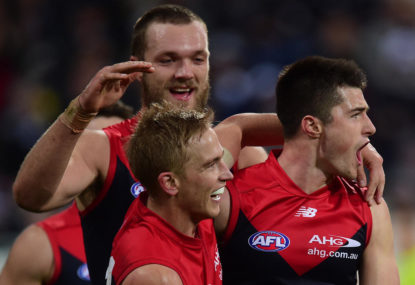I haven’t seen a Demon resurrection like this since Evil Dead 3: Army of Darkness.
Melbourne, long-suffering Melbourne, are on the march.
After five rounds the Dees have produced one bad performance – the inexplicable loss to Essendon – and have turned in good performances, with three wins and a narrow loss to league-leader North Melbourne.
The catalyst has involved a number of factors, including young, talented players maturing and stepping up and a newly aggressive approach to the game.
The Demons under Paul Roos have, until now, played like a really awful duplicate of a quintessentially Roos side.
Roos’ defensive game worked for Sydney because they had talent across the park and when they did move the ball forward they were blessed by the presence of Barry Hall and Michael O’Loughlin, ably supported by Ryan O’Keefe.
At Melbourne, it has produced grim viewing – until now. Melbourne showed glimpses of improvement last season, but now play the game like they actually enjoy it.
Against North, the Dees coughed up a huge early lead. Rather than fold, or just try to mitigate the damage, Melbourne stormed back into the match with exciting, risk-taking football. It’s easy to throw caution to the wind when you have nothing to lose, but Melbourne have continued to play confident, aggressive football.
Beneficiaries have included the long-maligned Jack Watts, with 12 goals this season. Watts has worked well with Jeff Garlett, the Swan Districts star who was misunderstood and badly-used by Carlton, and Jesse Hogan.
Jack Viney has always been a good player and is revelling in hitherto unknown levels of support. Viney, along with Dom Tyson, Bernie Vince, Nathan Jones and Matt Jones, is averaging 20-plus possessions a game. It’s not simply about getting the ball – the Dees are using it directly and with purpose.
The third factor is the rise of Max Gawn.
In short, the Demons are standing on the shoulders of a giant.
In his first 26 matches spread over five seasons, Gawn averaged 16.9 hit outs a game.
In 2015, Gawn was given the number 11 guernsey made famous by the rightfully revered Jim Stynes. He responded with 485 hit outs in 13 games, at 37.3 a match. A sleeping giant was starting to stir.
So far this season Gawn has been close to unstoppable.
In Round 1 he was instrumental in a tight win over Greater Western Sydney, with 14 touches and 26 hit outs against 25 from the experienced and gifted Shane Mumford. The significance of Melbourne’s win over the Giants has grown with the benefit of hindsight as – make no mistake – GWS marches towards its first finals series.
Round 2 delivered Melbourne’s loss to Essendon. Nevertheless Gawn almost doubled his direct opponent’s hit-out tally with 31.
The following week Melbourne charged back against North led by Gawn’s extraordinary performance: 63 hit outs, 18 touches and two goals – made all the more compelling by the fact he was facing Todd Goldstein who, until now, seemed the undisputed number one ruckman in the league.
Gawn delivered 47 hit outs, 18 touches, seven marks and two goals against Richmond, facing Ivan Maric, and mauled Collingwood with 37 hit outs, 15 touches and a goal.
A master in the ruck, Gawn is difficult to match-up as a forward pinch-hitter.
At this rate, opponents may well quote Revelations 13:4 and ask “Who is like unto The Beast? Who is able to make war with him?”
How does Gawn compare to the best of the modern era?
The game has changed a lot in the past 25 years. In 1992, Footscray big man Scott Wynd led the league hit outs per game – averaging just 17.1. He kicked zero goals in and averaged 18 touches – and won the Brownlow. Carlton luminary Justin Madden averaged 17.3 hit outs per game and his brother, Bomber Simon, less than 15.
More recent comparisons are more useful.
This season Gawn is averaging 40.8 hit outs, 15 touches, and one goal per game.
Since 2011 Todd Goldstein has averaged in the mid to high 30s for hit outs and 12-14 touches a game. Aaron Sandilands averaged 43 hit outs a game last season as the Dockers won the minor premiership. It was a stand-out season. In his two other best season he averaged 38.7 (2014) and 37.7 (2012), and otherwise ranged from the high 20s to the low 30s.
One swallow doesn’t make a summer, and there’s a way to go yet in the 24-year-old’s career, but if the Demons do manage to make the eight from here, a star ruckman can have a huge impact in high-pressure finals football.





























































































